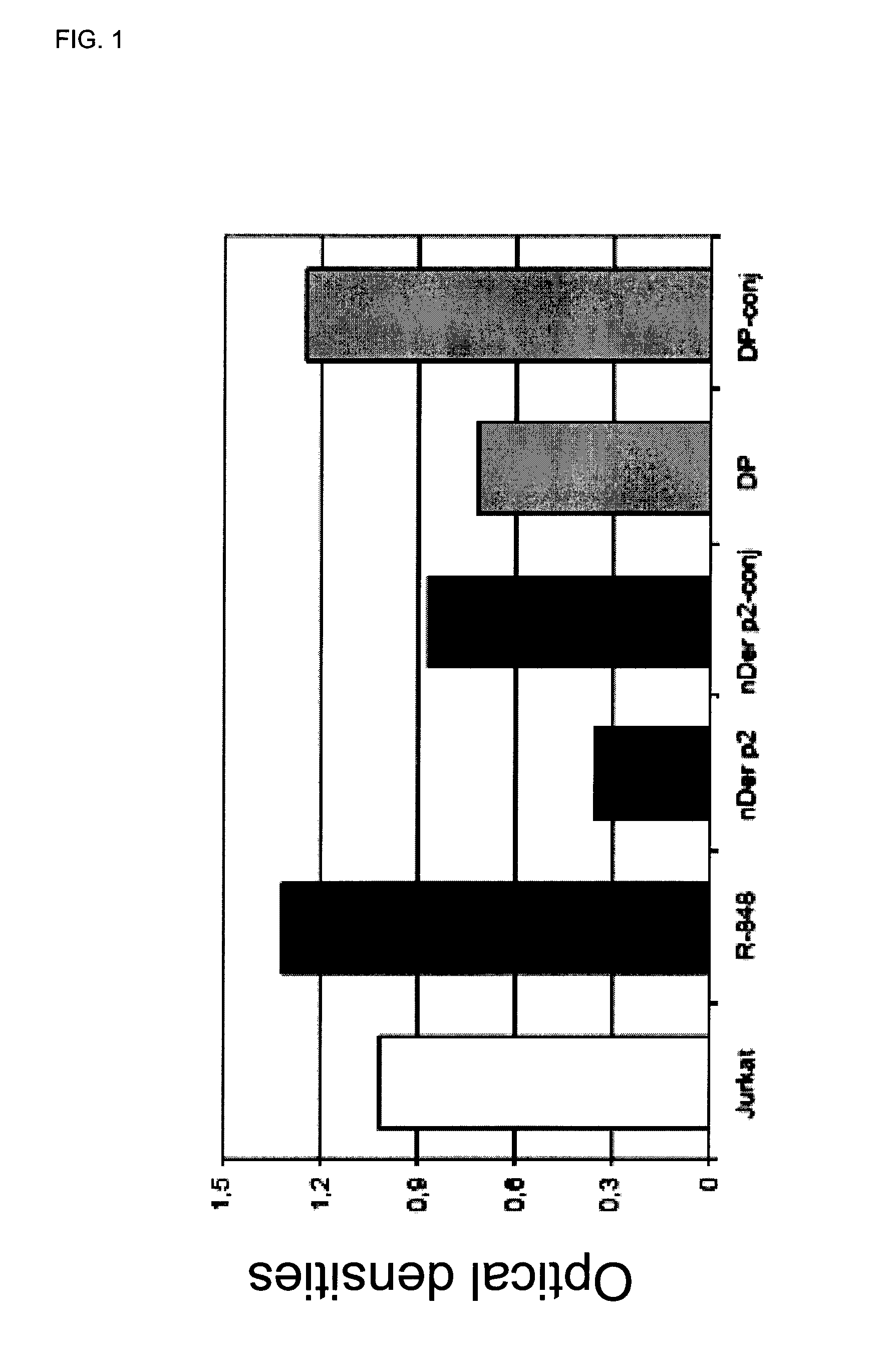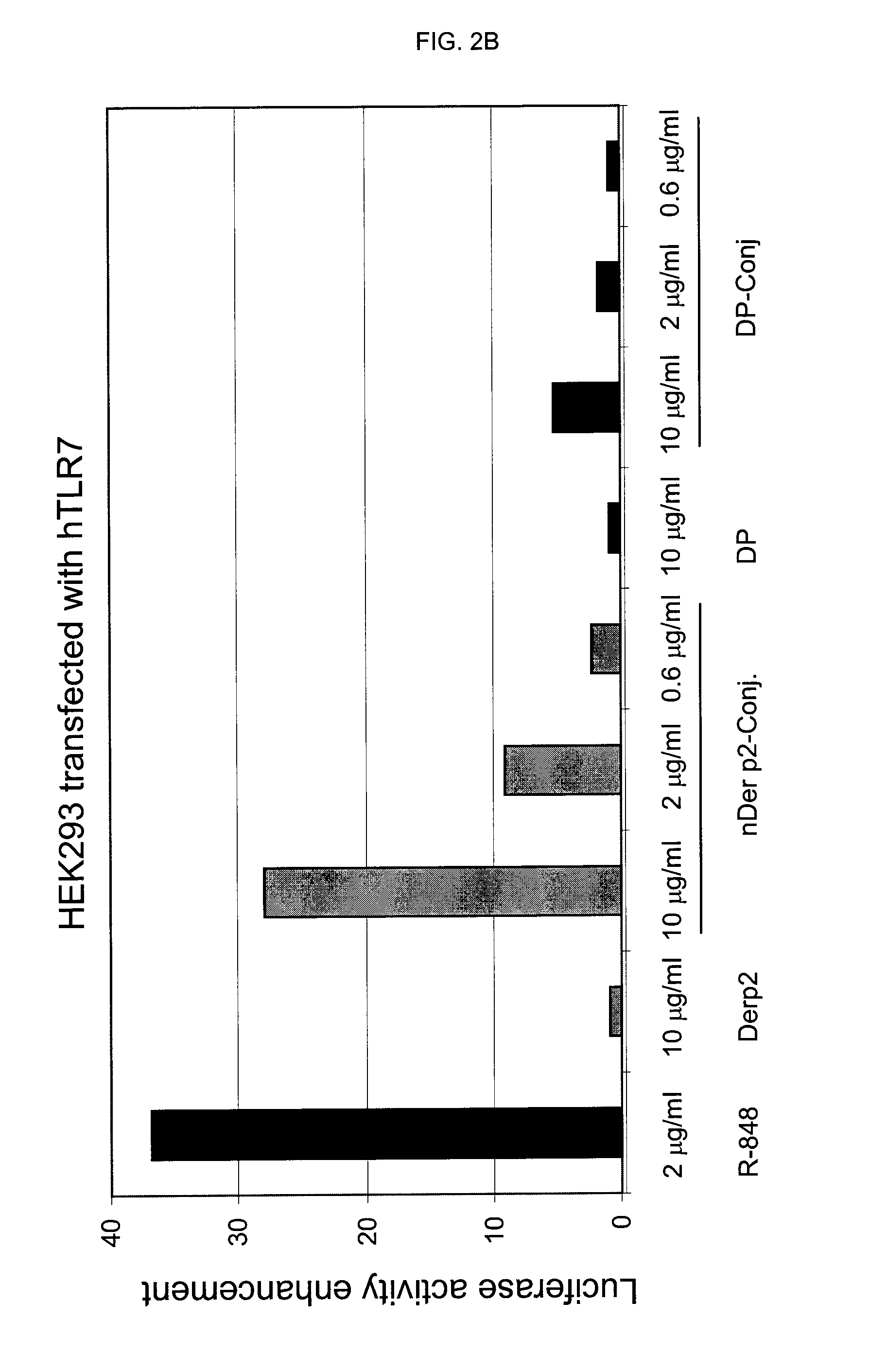Preparation of conjugates comprising adenine derivatives and allergenic proteins and their use for specific immunotherapy of allengenic diseases
a technology of allergen proteins and conjugates, which is applied in the field of vaccine preparations for specific immunotherapy, can solve the problems of determining an exaggerated release of mediators, unable to use sit, and unable to meet the profile of efficacy and safety
- Summary
- Abstract
- Description
- Claims
- Application Information
AI Technical Summary
Benefits of technology
Problems solved by technology
Method used
Image
Examples
example 1
Preparation of the active ester SA-26E
[0045]
[0046]Adenine derivative (III) known from the literature has initially been functionalized with a linker by treatment with ethyl 4-bromobutanoate (1 equiv.) in anhydrous DMF and in the presence of K2CO3 as a base. The product (IVa) is thus obtained in 54% yield after chromatography. The ethyl ester (IVa) so obtained is hydrolyzed in alkaline medium with KOH in a 3:1 methanol-water mixture. After 48 h, the methanol is evaporated and the pH of the resulting solution is adjusted to pH 3 by 10% NaHSO4, thus leading to the precipitation of acid (Va) (70% yield). The active ester SA26-E is prepared by dissolving the acid (Va) in anhydrous DMF and adding dicyclohexylcarbodiimide in a slight excess followed by N-hydroxysuccinimide according to standard conditions. After chromatography of the crude reaction mixture the active ester SA26-E is obtained in a 79% yield.
Step (a)—Procedure for the preparation of 4-(6-Amino-9-benzyl-8-hydroxy-9H-purin-2-y...
example 2
General Procedure for the Preparation of a Conjugate having Formula (II) between the Active ester SA26-E and the Protein Der p2
[0062]In a glass vial, the allergen nDer p2 (750 μg) is dissolved in 0.5 mL of a 0.1 M phosphate buffer at pH 7.4. The active ester (see Table), dissolved in DMSO (130 μL), is diluted to 1 mL with the same phosphate buffer and transferred into the vial containing the allergen (for a final volume of 1.5 mL). The solution is left under mechanical stirring at 4° C. for 18 h, and then is dialyzed. The conjugation with the protein nber p2 is carried out by employing an excess of active ester compared to the moles of lysine evaluated to be present on the amount of the protein used, as reported in the Table. The actual conjugation has been demonstrated by a MALDI-TOF analysis of the conjugates by which it is possible to observe the presence of the unconjugated protein (14.098 Kba) and the formation of conjugates having molecular masses of 14.439 and 14.781 Kba. The...
example 3
Evaluation of the Production of Innate Cytokines and Chemokines
Step (a)—Procedure for Stimulation of Cells from the Innate Immunity and Determination of Innate Cytokines and Chemokines
[0064]Circulating mononuclear cells (MNC) are isolated by density gradient (Ficoll-Hypaque) using buffy coats from 14 normal donors (Servizio Immunotrasfusionale e terapie cellulari, Azienda Ospedaliera Universitaria A. Meyer, Firenze). 200×106 MNC are separated by the use of a commercial kit (CD14 isolation kit, Miltenyi) by the addition of 400 μl anti-CD14 monoclonal antibody bound to iron beads followed by isolation on magnetic columns (LS column). 50×106 monocytes are recovered by positive selection and are extensively washed with calcium and magnesium-free sterile PBS and then seeded in complete medium plus 10% foetal calf serum in 24 flat bottomed plates at the concentration of 1×106 / ml. As stimulants, the following compounds have been used: unconjugated allergens (DP or nber) (10 μg / ml), their r...
PUM
| Property | Measurement | Unit |
|---|---|---|
| Mass | aaaaa | aaaaa |
| Molar density | aaaaa | aaaaa |
| Fraction | aaaaa | aaaaa |
Abstract
Description
Claims
Application Information
 Login to View More
Login to View More - R&D
- Intellectual Property
- Life Sciences
- Materials
- Tech Scout
- Unparalleled Data Quality
- Higher Quality Content
- 60% Fewer Hallucinations
Browse by: Latest US Patents, China's latest patents, Technical Efficacy Thesaurus, Application Domain, Technology Topic, Popular Technical Reports.
© 2025 PatSnap. All rights reserved.Legal|Privacy policy|Modern Slavery Act Transparency Statement|Sitemap|About US| Contact US: help@patsnap.com



